

Spazio CLIL. Create Interactive Online Presentations & free Infographic software. HTML5 Animations, download & Publish. Create and share visual ideas online. Create Easy Infographics, Reports, Presentations. Create Infographic - Sign in.
Exploiting Infographics for CLIL.
Inlingua Cheltenham. Bell - Extensive Reading: Why? and How? The Internet TESL Journal Timothy Bell timothy [at] hsc.kuniv.edu.kwKuwait University Abstract An extensive reading program was established for elementary level language learners at the British Council Language Center in Sanaa, Yemen.
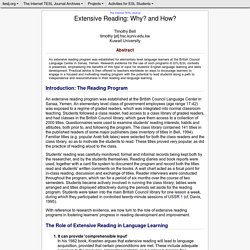
What is CLIL? CLIL stands for Content and Language Integrated Learning and refers to teaching subjects such as science, history and geography to students through a foreign language.
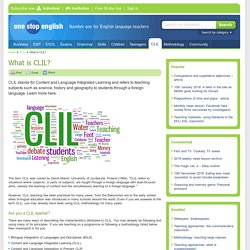
Learn more here. The term CLIL was coined by David Marsh, University of Jyväskylä, Finland (1994): "CLIL refers to situations where subjects, or parts of subjects, are taught through a foreign language with dual-focused aims, namely the learning of content and the simultaneous learning of a foreign language. " However, CLIL teaching has been practised for many years, from the Babylonian era to the early sixties when bi-lingual education was introduced in many schools around the world. Even if you are unaware of the term CLIL, you may already have been using CLIL methodology for many years. Course: TECHNO CLIL EVO 2017 , Topic: Week 1: Jan 8-14. Article: Skills for CLIL. In this article John Clegg outlines the language and learning skills which a learner learning a subject through the medium of English as a second language (L2) requires. 1.

Introduction What I want to do in this article is outline the language and learning skills which a learner learning a subject through the medium of English as a second language (L2) will need. This learner is typically learning the whole of the subject in English for some years or throughout schooling. Thinking skills for CLIL. By Jean Brewster In the first of a new series of study skills for CLIL, Jean Brewster takes the very topical subject of thinking skills and looks at how CLIL teaching embraces many of the thinking skills principles and how this benefits the learner.
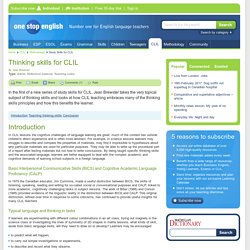
In CLIL lessons the cognitive challenges of language learning are great; much of the content lies outside children's direct experience and is often more abstract. Interactive presentation software - Mentimeter. Content and Language Integrated Learning. In ELT, forms of CLIL have previously been known as 'Content-based instruction', 'English across the curriculum' and 'Bilingual education'.
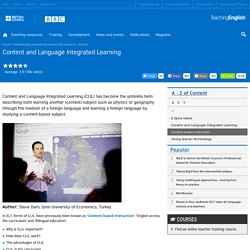
Why is CLIL important? How does CLIL work? The advantages of CLILCLIL in the classroomThe future of CLILWhere is CLIL happening? Why is CLIL important? Explaining BICS and CALP. Basic Interpersonal Communication Skills Experts such as Jim Cummins differentiate between social and academic language acquisition.
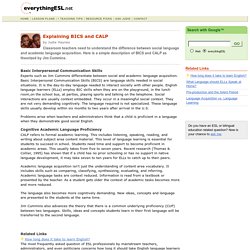
Basic Interpersonal Communication Skills (BICS) are language skills needed in social situations. Volume 2016 – Issue 4. CLIL and CALL for a teacher’s expertise: an international training experience. Abstract The paper deals with the link between Content and Language Integrated Learning (CLIL) and Computer Assisted Language Learning (CALL), that is the use of ICT to enhance language teaching-learning and the teaching of subject content in a foreign language.
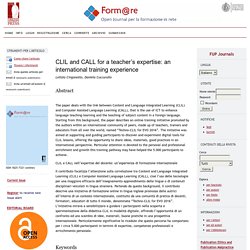
Starting from this background, the paper describes an online training initiative promoted by the authors within an international community of peers, made up of teachers, trainers and educators from all over the world, named “Techno-CLIL for EVO 2016”. The initiative was aimed at supporting and guiding participants to discover and experiment digital tools for CLIL lessons, offering the opportunity to share ideas, materials, good practices in an international perspective. Particular attention is devoted to the personal and professional enrichment and growth this training pathway may have helped the 5.000 participants to achieve.
CLIL Magazine Spring 2016 by Patrick de Boer. The Consultants-E : EdTech Training - Face-to-Face. We offer a series of workshops on how to implement ICT tools in the classroom.

These are aimed at teachers, teacher trainers, directors, and educators in general. All of our workshops are communicative, hands-on, and based in real classroom practice. Practising teachers leave our workshops with clear ideas on how to implement these tools in their own teaching. With a minimum group size of 6, and a maximum of 25, participants are guaranteed a personal service geared towards addressing common problematic areas associated with the implementation of technology in teaching, as well as practical, hands-on work which - when applied - can have an immediate and positive impact on their professional lives.
CLIL Glossary. CLIL IN ACTION – TEAM TEACHING. Article: Teacher collaboration in CLIL. By John Clegg In this article, John Clegg states the importance of CLIL teachers collaborating with others to create a powerful learning system.

Teachers who teach their subject in a second language often have to collaborate. Of course we know that all teachers need to collaborate for one reason or another, but CLIL teachers need it more than most. What is Web 2.0. Web 2.0 is the current state of online technology as it compares to the early days of the Web, characterized by greater user interactivity and collaboration, more pervasive network connectivity and enhanced communication channels.
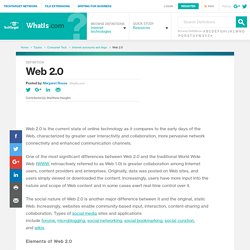
One of the most significant differences between Web 2.0 and the traditional World Wide Web (WWW, retroactively referred to as Web 1.0) is greater collaboration among Internet users, content providers and enterprises. Originally, data was posted on Web sites, and users simply viewed or downloaded the content. Increasingly, users have more input into the nature and scope of Web content and in some cases exert real-time control over it. The social nature of Web 2.0 is another major difference between it and the original, static Web. Increasingly, websites enable community-based input, interaction, content-sharing and collaboration. INTEGRATING MOBILE DEVICES INTO LANGUAGE LEARNING TO MEET THE 21ST CENTURY EDUCATIONAL CHALLENGES. Home » novembre Abstract This paper focuses on the value added by digital and mobile learning to the development of language competences and to the teaching/learning of subject content in a foreign language through CLIL methodology (Content and Language Integrated Learning).
The European Commission recommends CLIL as one of the most innovative strategies for the modernization of our education and training system. CLIL links - A trip to CLIL. Web2 - 4 Languages Teachers - Web2.0 tools. TECHNOCLIL – By Leda – Letizia Cinganotto & Daniela Cuccurullo. 4-dimensional storytelling. Digital Literacy and Open Content Curation for CLIL. Digital literacy is surfing the net with a critical eye. Designing a digital project, including digital resources and content in it often involves remixing content created by others. Digital citizenship implies the responsible use of online images, texts, videos, audios and so forth. We must learn to respect copyright, and to identify where we have found images, text, sounds, videos, and so on, so we can teach our students to be respectful too. Part of digital citizenship and literacy is that we have to responsibly use online materials. Article: Planning CLIL lessons.
By John Clegg To overcome the language barrier, CLIL teachers need to plan their lessons to include language support as well as content teaching. John Clegg explores the strategies that can be applied. Putting CLIL into Practice - factworld.info. A CLIL book from OUP. It feels like it has taken years to get this book together, but actually, it's about two years. OUP have provided us with a publicity flier which I'm posting here so that any interested colleagues can see what to expect. In terms of content, one of the main things I think we offer in the book is a clear description of a framework for describing and implementing CLIL practice. Robert Quinn - ELT & CLIL Links. Iwb.org.uk ~ Free Interactive Whiteboard Resources. Ourselves, Science, Key Stage 1 - Interactive Whiteboard Resources. Our BodiesFlash An excellent lesson on naming the parts of the human body. Ourselves Science ClipsFlash For 5 - 6 year olds, this site looks at differences between living and non-living things, the names of the main body parts of humans and animals and how animals move in different ways.
Healthy EatingFlash A series of superb interactive screens which introduce children to healthy eating. EiS Kent - EiS Kent - Providing Support to schools in Kent. Www.bgfl.org. Welcome to Crickweb. Give CLIL time. Quaderno n. 14. CLIL - Content and Language Integrated Learning- What is CLIL?
Scaffolding Definition. Vgclil. Creating social phrasebooks with Phraseum. Telescopic Text. Help Center. Use Text-to-Speech Technology Online to Read with Your Ears. Digital Graphic Organizers: A Study Tool for Kids with Dyslexia. 10 Ways to Use Technology to Build Vocabulary. Fiabe, Favole e racconti……da vivere ed ascoltare. « RI-MEDIARE LA SCUOLA. 1 WORKSHEET – 10 GAMES. CLIL. Stephen Krashen's Theory of Second Language Acquisition (Assimilação Natural - o Construtivismo no Ensino de Línguas) A Quick Guide to the Flipped Classroom. Khan Academy. Clilstore - Teaching units for content and language integrated learning. The practice and theory of CLIL.
TED: Ideas worth spreading. CLIL worksheets. Download free sample material from onestopclil. Università di Foggia. Resource Centre - Useful Material.